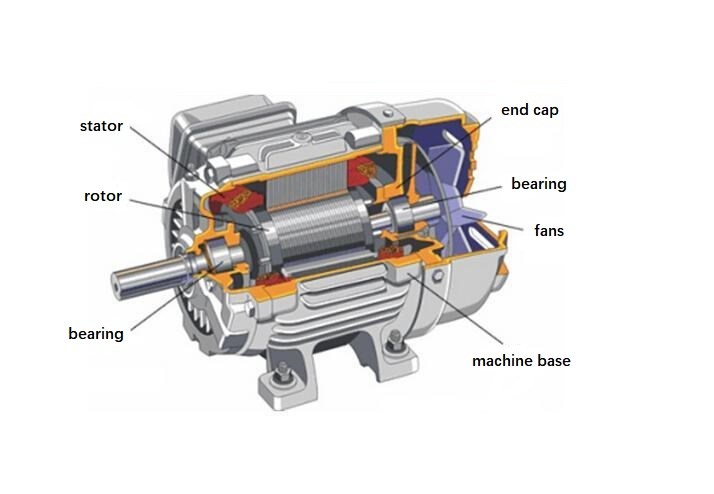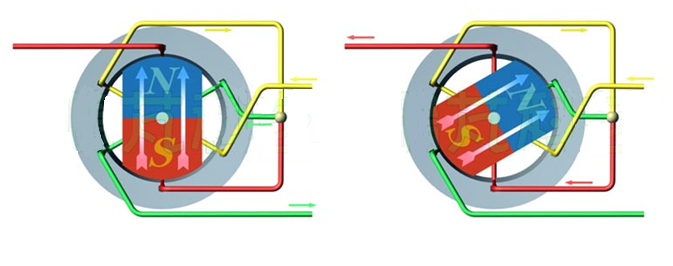QINGDAO ENNENG MOTOR CO.,LTD. |
|
Verified Suppliers
|
|
Eco Friendly Natural Cooling Permanent Magnet Synchronous Motor

What Is The Permanent Magnet Synchronous Motor?

The PERMANENT MAGNET SYNCHRONOUS MOTOR is mainly composed of the stator, rotor, chassis, front-rear cover, bearings, etc. The structure of the stator is basically the same as that of ordinary asynchronous motors, and the main difference between the permanent magnet synchronous motor and other kinds of motors is its rotor.
The permanent magnet material with pre-magnetized (magnetic charged) magnetic on the surface or inside the permanent magnet of the motor, provides the necessary air gap magnetic field for the motor. This rotor structure can effectively reduce the motor volume, reduce loss and improve efficiency.
Analysis of the principle of the technical advantages of permanent magnet motor
The principle of a permanent magnet synchronous motor is as follows: In the motor's stator winding into the three-phase current, after the pass-in current, it will form a rotating magnetic field for the motor's stator winding. Because the rotor is installed with the permanent magnet, the permanent magnet's magnetic pole is fixed, according to the principle of magnetic poles of the same phase attracting different repulsion, the rotating magnetic field generated in the stator will drive the rotor to rotate, The rotation speed of the rotor is equal to the speed of the rotating pole produced in the stator.

Due to the use of permanent magnets to provide magnetic fields, the rotor process is mature, reliable, and flexible in size, and the design capacity can be as small as tens of watts, up to megawatts. At the same time, by increasing or decreasing the number of pairs of rotor permanent magnets, it is easier to change the number of poles of the motor, which makes the speed range of permanent magnet synchronous motors wider. With multi-pole permanent magnet rotors, the rated speed can be as low as a single digit, which is difficult to achieve by ordinary asynchronous motors.
Especially in the low-speed high-power application environment, the permanent magnet synchronous motor can be directly driven by a multi-pole design at low speed, compared with an ordinary motor plus reducer, the advantages of a permanent magnet synchronous motor can be highlighted.


Differences Between The Permanent Magnet Motor And Asynchronous Motor
01. Rotor Structure
Asynchronous motor: The rotor consists of an iron core and a winding, mainly squirrel-cage and wire-wound rotors. A squirrel-cage rotor is cast with aluminum bars. The magnetic field of the aluminum bar cutting the stator drives the rotor.
PMSM Motor: The permanent magnets are embedded in the rotor magnetic poles, and are driven to rotate by the rotating magnetic field generated in the stator according to the principle of magnetic poles of the same phase attracting different repulsions.
02. Efficiency
Asynchronous motors: Need to absorb current from the grid excitation, resulting in a certain amount of energy loss, motor reactive current, and low power factor.
PMSM Motor: The magnetic field is provided by permanent magnets, the rotor does not need exciting current, and the motor efficiency is improved.
03. Volume And Weight
The use of high-performance permanent magnet materials makes the air gap magnetic field of permanent magnet synchronous motors larger than that of asynchronous motors. The size and weight are reduced compared to asynchronous motors. It will be one or two frame sizes lower than asynchronous motors.
04. Motor Starting Current
Asynchronous motor: It is directly started by power frequency electricity, and the starting current is large, which can reach 5 to 7 times the rated current, which has a great impact on the power grid in an instant. The large starting current causes the leakage resistance voltage drop of the stator winding to increase, and the starting torque is small so heavy-duty starting cannot be achieved. Even if the inverter is used, it can only start within the rated output current range.
PMSM Motor: It is driven by a dedicated controller, which lacks the rated output requirements of the reducer. The actual starting current is small, the current is gradually increased according to the load, and the starting torque is large.
05. Power Factor
Asynchronous motors have a low power factor, they must absorb a large amount of reactive current from the power grid, the large starting current of asynchronous motors will cause a short-term impact on the power grid, and long-term use will cause certain damage to the power grid equipment and transformers. It is necessary to add power compensation units and perform reactive power compensation to ensure the quality of the power grid and increase the cost of equipment use.
There is no induced current in the rotor of the permanent magnet synchronous motor, and the power factor of the motor is high, which improves the quality factor of the power grid and eliminates the need to install a compensator.
06. Maintenance
Asynchronous motor + reducer structure will generate vibration, heat, high failure rate, large lubricant consumption, and high manual maintenance cost; it will cause certain downtime losses.
The three-phase Permanent magnet synchronous motor drives the equipment directly. Because the reducer is eliminated, the motor output speed is low, mechanical noise is low, mechanical vibration is small, and the failure rate is low. The entire drive system is almost maintenance-free.
Application:
Permanent magnet synchronous motors can be combined with frequency converters to form the best open-loop step-less speed control system, which has been widely used for speed control transmission equipment in petrochemical, chemical fiber, textile, machinery, electronics, glass, rubber, packaging, printing, paper making, printing and dyeing, metallurgy and other industries.
Why choose permanent magnet ac motors?
Permanent magnet AC (PMAC) motors offer several advantages over other types of motors, including:
High Efficiency: PMAC motors are highly efficient due to the absence of rotor copper losses and reduced winding losses. They can achieve efficiencies of up to 97%, resulting in significant energy savings.
High Power Density: PMAC motors have a higher power density compared to other motor types, which means they can produce more power per unit of size and weight. This makes them ideal for applications where space is limited.
High Torque Density: PMAC motors have a high torque density, which means they can produce more torque per unit of size and weight. This makes them ideal for applications where high torque is required.
Reduced Maintenance: Since PMAC motors have no brushes, they require less maintenance and have a longer lifespan than other motor types.
Improved Control: PMAC motors have better speed and torque control compared to other motor types, making them ideal for applications where precise control is required.
Environmentally Friendly: PMAC motors are more environmentally friendly than other motor types since they use rare earth metals, which are easier to recycle and produce less waste compared to other motor types.
Overall, the advantages of PMAC motors make them an excellent choice for a wide range of applications, including electric vehicles, industrial machinery, and renewable energy systems.
How to prevent the demagnetization of permanent magnet motors?
01. Correct selection of permanent magnet motor power:
Demagnetization is related to the power selection of permanent magnet motors. Correct selection of PM motor power can prevent or delay demagnetization. The main reason for the demagnetization of the permanent magnet synchronous motor is that the temperature is too high, and the overload is the main reason for the high temperature. Therefore, a certain margin should be left when selecting the power of the permanent magnet motor. According to the actual situation of the load, generally, about 20% is more appropriate.
02. Avoid heavy load starting and frequent starting:
Permanent magnet synchronous motors try to avoid direct starting or frequent starting of heavy loads. During the starting process, the starting torque is oscillating, and in the valley section of the starting torque, the stator magnetic field is demagnetizing the rotor magnetic pole. Therefore, try to avoid the heavy load and frequent starting of the permanent magnet synchronous motor.
03. Improve the design:
(1) Appropriately increase the thickness of the permanent magnet:
From the perspective of permanent magnet synchronous motor design and manufacture, the relationship between armature reaction, electromagnetic torque, and permanent magnet demagnetization should be considered.
Under the combined action of the magnetic flux produced by the torque winding current and the magnetic flux produced by the radial force winding, the permanent magnets on the rotor surface easily cause demagnetization.
Under the condition that the air gap of the motor remains unchanged, to ensure that the permanent magnet does not demagnetize, the most effective method is to appropriately increase the thickness of the permanent magnet.
(2) There is a ventilation groove circuit inside the rotor to reduce the temperature rise of the rotor:
If the temperature of the rotor is too high, the permanent magnet will cause irreversible loss of magnetism. In the structural design, the internal ventilation circuit of the rotor can be designed to directly cool the magnetic steel. Not only reduces the temperature of the magnetic steel but also improves the efficiency.